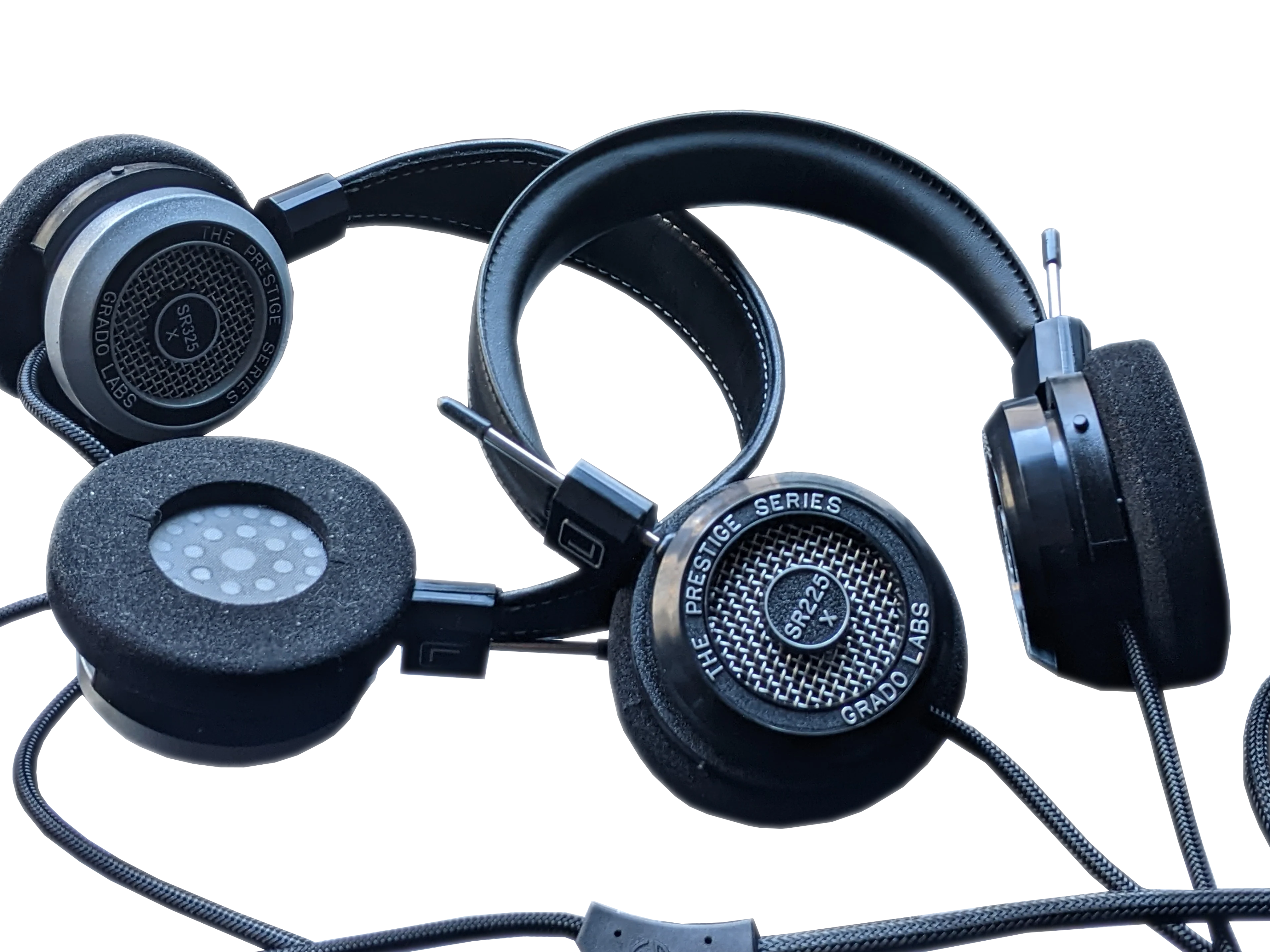Grado SR325x vs SR225x Comparison Review
Grado Labs has been making their distinct headphones in Brooklyn since 1953, giving a wide array of lines and series that are built on a history of refinement. In 2021, Grado took their Prestige line and gave it the chef's kiss with their newly updated 4th generation dynamic drivers as well as some aesthetic touch-ups. The result was a more vibrant sound with the same distinctly energetic Grado character that so many people swear by. Today, I'm taking a look at the king of the series, the SR325x, and the second in command, the SR225x, priced $295 and $225 respectively. What's the same? What's different? Believe it or not, that's what we'll be discussing today.

Look and Feel
Both the SR325x and the SR225x have the same F cushion earpads. Both come with a new wire that's been upgraded to include sturdier insulation (and a better technical design which we'll touch on later). Also in common are the classic Grado sliders, which are metal and swivel completely freely on their vertical axis. The speakers are on-ear for both models, and sit flatly against the ear.
As for the differences, the most obvious one is the cans: the SR325x is the only headphone in the new Prestige line that shines with an all metal housing, while the SR225x is mostly a black plastic housing besides the open-back metal grill (which all Prestige X's feature). The headbands are quite different as well: while the SR225x is equipped with the same headband as the other headphones in the line (leather encased memory foam), the SR325x features a slightly wider, more realistic leather band with white stitching. Though the headband is acceptably comfortable on both models, I'm a little curious as to why Grado shirked the cushioning for the SR325x, as it seems like a more luxurious quality to include on a headphone. Even if the headband material is ever so slightly more comfortable on the SR225x, the real difference in comfort comes into play when looking at their clamp pressures, where the 225 is a bit tighter than the 325. This difference is slight but noticeable, as it gets emphasized by the hard flat feeling of the speakers up against your ears.
The weight of the two headphones differ significantly, with the SR225x weighing only 280 grams and the SR325x a heavier 340 grams with its metal housing.
Design
Both the 325 and the 225 are now equipped with Grado's 4th generation dynamic drivers. These feature a more magnetic circuitry, a lighter voice coil and an improved diaphragm. Grado states that these features result in reduced distortion, improved efficiency and greater harmonic clarity. A new super annealed copper 8 conductor cable has also been included with all Prestige X headphones, which also features more insulation and sturdiness. The annealing process leads to more malleable, less brittle circuitry.
Unique to the SR325x, however, is the all metal housing that I've been mentioning. This design choice was implemented in order to improve the unit's accuracy and layering.
Grado SR325x Grado SR225x
-44mm Dynamic Driver -44mm Dynamic Driver
-Frequency Response: 18Hz – 24kHz -20Hz - 22kHz
-Sensitivity: SPL 1mW: 98dB -99.8 dB
-Impedance: 32 ohms -32 ohms

Sound Stage
Both pairs of headphones have a distinctly energetic sound; this is pretty much a Grado signature that extends beyond the Prestige X series. Some other personality traits they have in common: a surprisingly strong sub response (especially for open backs), fiery high mids, and a penchant for driving busy mixes with a bold harmonic layer. Though undeniably hailing from the same family, there are some significant differences to be heard between the two.
Firstly, there's the sound image. The SR225x has a tendency to follow a more linear left-right plane. Depth is present at points, but it takes something like a phaser or chorus to “activate” it, so to speak. The SR325x, however, really seems to benefit from its metal build in this department. While it may not have the biggest image, I found it to be nice and round, placing tracks all around my head in a cozy, wondrous sphere. To put it bluntly, the SR225x is an arrow through an apple on the top of your head, while the SR325x is like wearing an astronaut's helmet. Don't get me wrong: the imaging on the 225x is pretty solid and by no means a disappointment, but in a contest with the 325x, there is a clear winner.
While there is in some ways a similar EQ balance in the two headphones, I found that SR325x to handle itself more competently. Both seem to have a shelved boost in the lows and some peaks in the high mids and low highs. While the SR225x seems to lose a little clarity in the surrounding area around these boosts, the SR325x is more commanding, keeping its boosts tighter and not letting them spill over into the surrounding frequencies. As I'll detail below, it's really the treatment of the low mids that set these two pairs apart the most.
Lows
I really couldn't resist using both of these headphones on louder genres, and found myself listening through Tame Impala's discography for a good while when I was testing the SR325x and SR225x. When I listened to their track Nangs, some pretty obvious differences started to appear. The opening synth part is thick with frequencies all across the spectrum, which the 325x ran naturally, adding some beef but staying fairly even handed, leaving enough room for the accompanying bass part to come in a few measures later with impact and clarity. The 225x was more like the friend you have who asks if they can EQ your car speakers when they're in the passenger seat, and then immediately fat fingers 4 dB to the bass before turning to you and giving you a thumbs up. It applied a pretty great but heavy handed rumble to the opening synth part, that somewhat started to detract from the mix when the accompanying bass part also loudly jumped into the mix, making the proverbial pool spill over just a little too much. The 325x has a mature sense of where it's subs begin and where they end, where the 225x can occasionally run its low end boost into the low mids and lose some of its clarity.
Mids
I love writing about the mids on Grado's, as they are so, so intentionally bold and really showcase the creative side of the engineers who made them. Both the 325x and 225x gave distorted guitars some extra agressive fuzzy teeth, and brought out really warm and satisfying thumps from both tom-tom and snare transients on acoustic kits. Vocals end up particularly loud (and walk the line of being occasionally shrill) in both headphones with the obvious heavy peak in the high mids. Once again, however, the 325x wins as a result of its self control. The 225x sometimes can sound a little overwhelmed in its high mids when things start getting too loud in the region, losing the finer details of the tracks and instead creating a layer of sound that is more like a total sum of the parts. Interestingly, I'd say this summed harmonic layer still exists on the SR325x, but without losing its more natural “original” balance. An analogy for those who know something about mixing music: the 225x sounds like it has a saturater on the mids placed directly on its channel strip, where as the 325x has it's middle saturation bussed in on an aux track.
Highs
Finally the competition cools off a bit and the SR225x and SR325x start seeing more eye-to-eye in the highs. I couldn't find much of difference between the two, as both units even had the same specific additional depth present in their high frequencies. The mids do so much aggressive heavy lifting that the highs actually provide a little relief; not that they're quiet, but they probably produce the most natural sounds on otherwise exceptionally eccentric headphones. The balance on both sets had a really nice expression on Colin Stetson tracks, whose sax buzzed brightly through the mids as his deep breaths were heard crisply in the highs. Maybe the only difference worthy of noting is that the 325x might have had some nicer sounding highs, but only in the context of having better control over the neighboring frequencies.

Overall
It may seem obvious at this point that Grado's SR325x impressed me a bit more than the SR225x; this isn't a controversial stance, as this was obviously Grado's intention. Yes, the 325x has more precision in the same boosted lows and mids present in the 225x, and produces a rounder, more vibrant sonic image, but please don't misunderstand what I'm saying: the SR225x is certainly a comparable headphone and was still a ton of fun to listen with. There's a $70 difference between the two, which isn't a terribly wide gap, and is very appropriate as there is a moderate but by no means huge difference between the experience both models are able to provide. If you're shopping in the $200-300 range for an on-ear, seriously: try both, you won't be disappointed that you did.


 FREE Shipping
FREE Shipping




